Blockchain at Walmart: Tracking Food from Farm to Fork
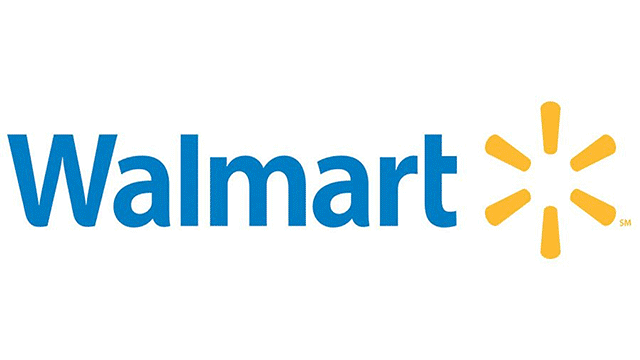
Tracing one step at a time
Food safety has always been a global concern. According to the World Health Organization, about 420,000 people die each year due to food poisoning.
In the U.S. alone, the total cost caused by food-related concerns—spanning from medical costs to economic loss due to halted productivity—range from $55.5 billion to $93.2 billion a year. This cost has increased by 20% in the last four years according to IBM.
In 2006, the E.coli spinach outbreak affected 26 states. There were 199 cases. Among those affected, 102 were hospitalized and 31 suffered kidney failure called the hemolytic-uremic syndrome. There were three confirmed deaths after the outbreak.
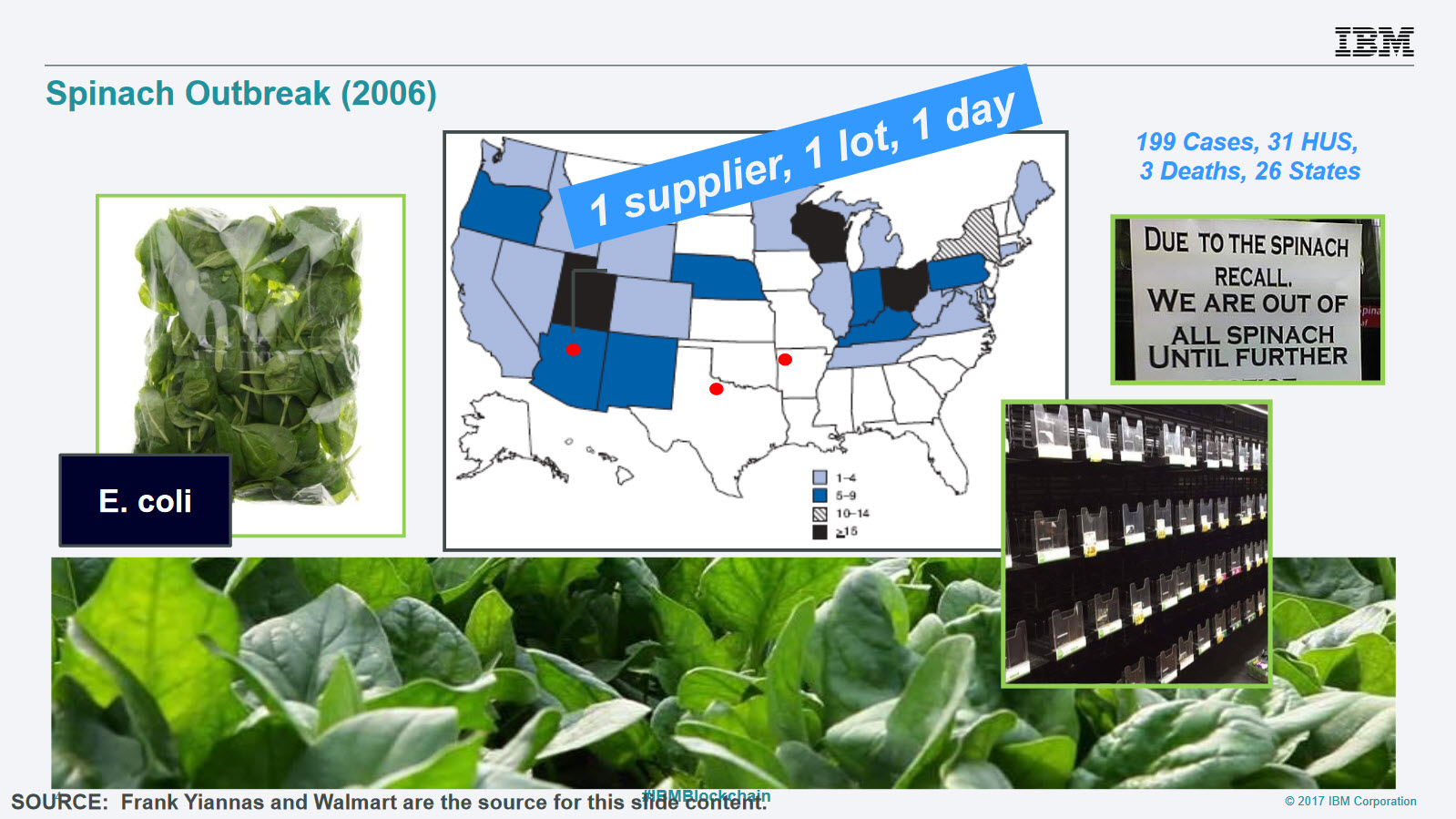 Food and Drug Administration took two weeks to find the source (Source)
Food and Drug Administration took two weeks to find the source (Source)In 2011, the Listeriosis Cantaloupe outbreak affected 28 states. Of the 147 cases, 143 people were hospitalized and the death toll reached a staggering count at 33.
More recently, a new outbreak of Salmonella infections has been linked to the imported Maradol Papayas. There were 173 cases in 21 states with 58 people hospitalized. There was a single confirmed death.
This August, millions of eggs were recalled all over Europe. The eggs tainted with the insecticide Fipronil were imported from the Netherlands to supermarkets across Europe.
These food-borne illnesses happen all over the world. In most cases, it takes authorities days if not weeks to isolate the problem before it can be contained.
Why does it take that long to trace the source? It’s slow because participants in the food industry supply chain each have their own information silos. Food can only be traced one step at a time.
Blockchain in combination with the Internet of Things (IoT) might just be able to solve this problem.
How can blockchain and IoT help?
Rather than going through all the basics, we’re going to instead highlight two things that blockchain brings to the food retail industry—traceability and transparency.
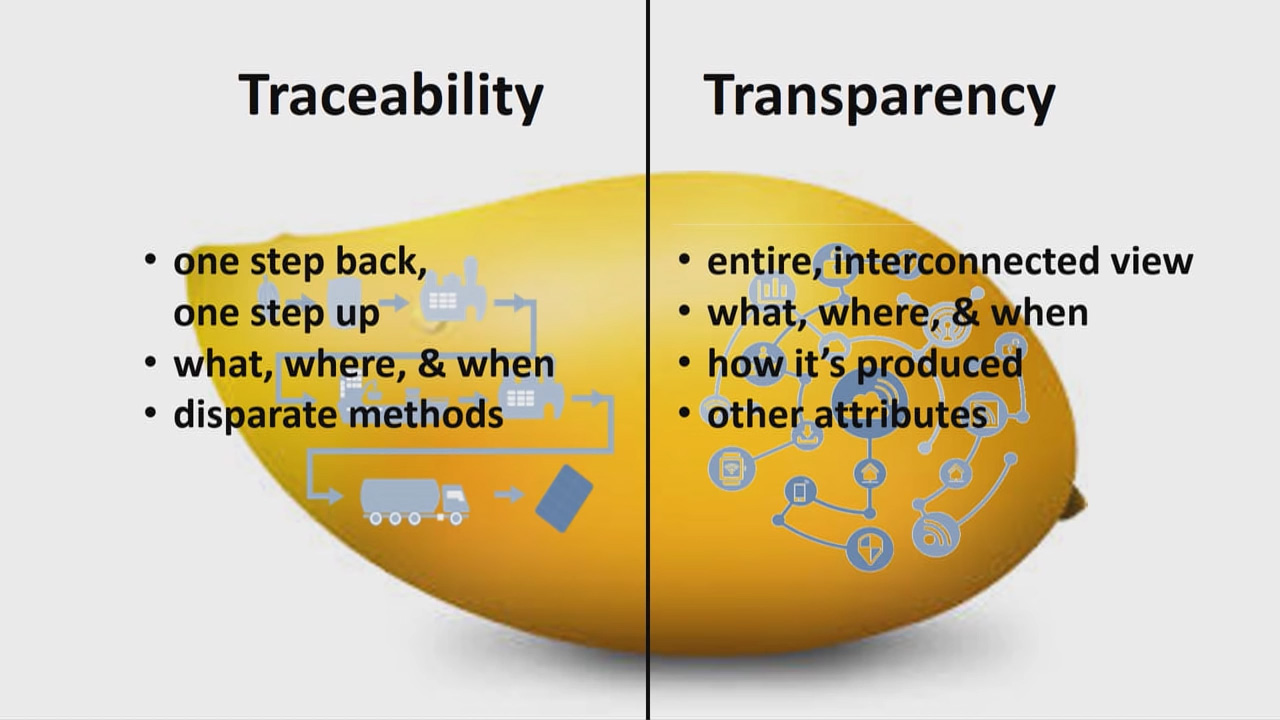 Food traceability and transparency on a blockchain (Source)
Food traceability and transparency on a blockchain (Source)According to Walmart’s Vice President of Food Safety, Frank Yiannis, traceability includes data points, such as farm location, lot number, and harvest date. On the other hand, transparency tells us how food was produced, was it grown organically, were pesticides used?
With blocklchain’s innate decentralization of information, the need for intermediaries is removed. Tracing one step at a time when tracking food because organizations have separate information silos is eliminated.
“We believe that blockchain has the potential of shining a light on the food system, bearing transparency, and that transparency driving appropriate self-desired behaviors.”
—Frank Yiannis, Walmart
These two aspects of blockchain lead to six improvements to the food industry:
- Improves food safety. By being able to pinpoint tainted food in a matter of moments, prolonged outbreaks can be mitigated.
- Fresher food. With each step being tracked in blockchain, consumers can see exactly when a food product was harvested.
- Less food wasted. According to the Food and Agriculture Organization of the United Nations, up to one third of food produced is wasted each year. This is in part due to clean food being thrown away during outbreak scares. Being able to isolate tainted food down to a farm and a batch level can stop this.
- Deters food fraud. Each step in the supply chain is visible to everybody. Fraudulent food entering the market—like the horse meat scandal of 2013 in Europe—can be avoided.
- Promotes responsible food practices. Similar to fraud detection, with each step in the process visible on blockchain, producers will be more likely to adhere to safe practices.
- Builds consumer trust. Consumers could have the power to scan individual food products and receive information about a food item from the farm it came from, to the grocery store.
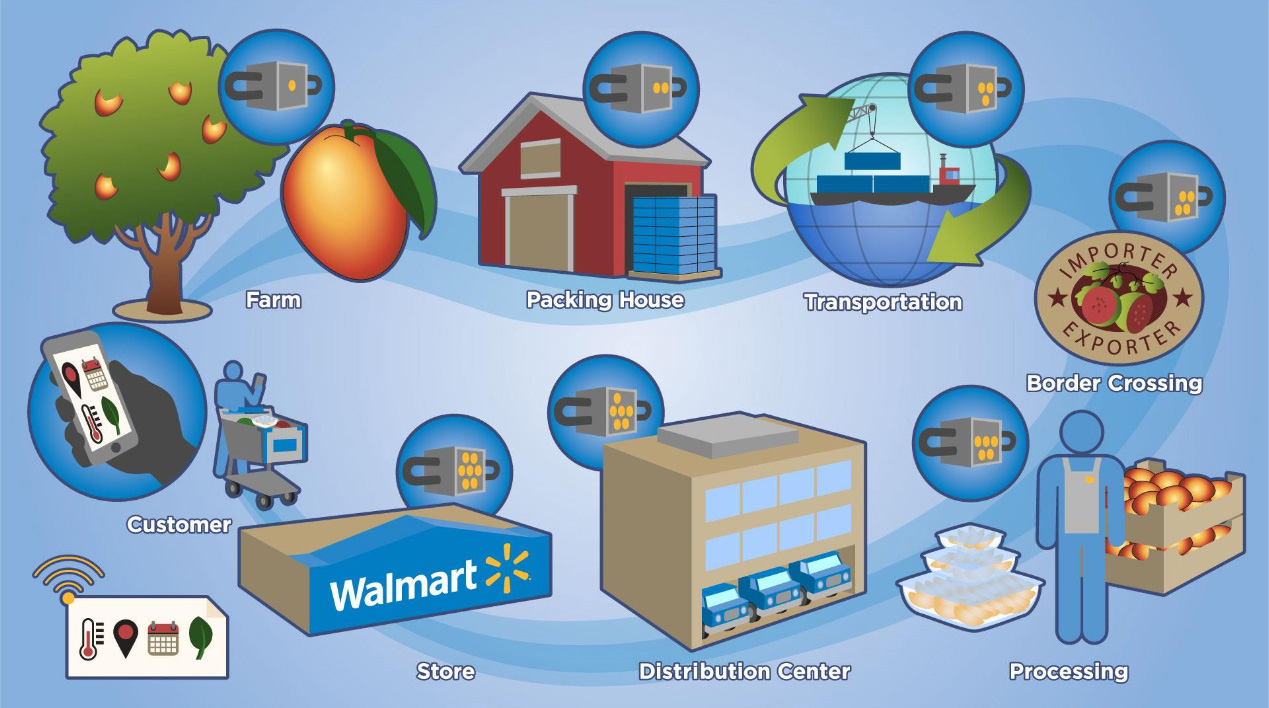 Blockchain enables tracking food from farm to fork (Source)
Blockchain enables tracking food from farm to fork (Source)The IoT technology, such as sensors and RFID tags, enable real-time data to be written on blockchain as food products pass along the supply chain.
Both technologies serve to help Walmart enforce systems such as the Hazard Analysis and Critical Control Point and comply with food safety regulations and regulators such as the Food Safety Modernization Act and the Food Safety and Inspection Service.
“If the system can be used to enhance food safety, that’s value to the U.S. economy. For every 1% reduction in food-born diseases in the United States, that’s a savings to the U.S. economy of about $700 million.” —Frank Yiannis, Walmart
What’s really tracked?
In 2016, Walmart, IBM, and Tsinghua University began collaboration on a blockchain pilot that traced pork in China using the IoT sensors along the supply chain. Later, a second blockchain pilot was launched, tracing Mexican mangoes in the US.
Developed using the Hyperledger blockchain technology, the pilots were designed to accurately record the following:
- Farm origin data
- Batch number
- Factory and processing data
- Expiration dates
- Storage temperatures
- Shipping details
Though the scale of the projects were limited, there were positive results seen. Frank demonstrated how food tracking that would usually take seven days could be done in 2.2 seconds with blockchain.
Once the blockchain projects scale to include 10 or more nodes, IBM believes it can save the industry “billions of dollars.”
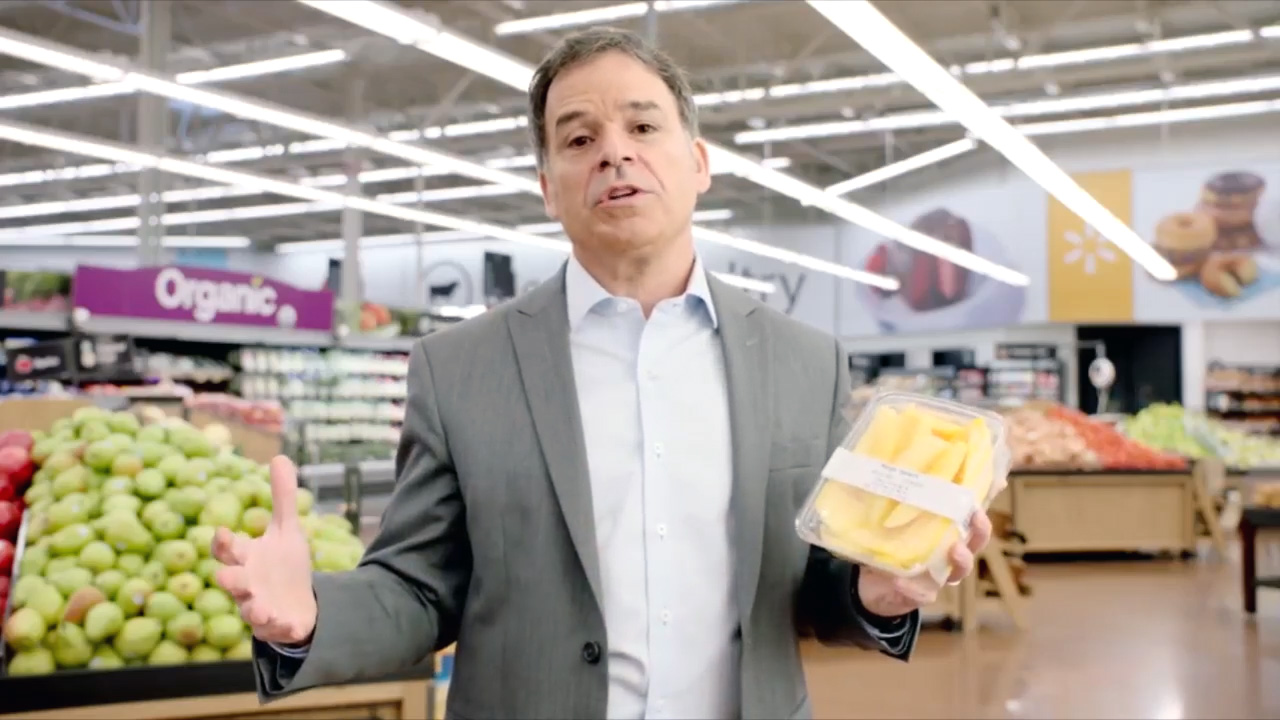 Frank Yiannas of Walmart (Source)
Frank Yiannas of Walmart (Source)“We believe we can do that traceability in minutes, maybe even seconds, not days and not weeks.” —Frank Yiannis, Walmart
Walmart also uses IBM Watson to predict patterns in retail by analyzing policies and variables that influence the supply chain.
In addition to speeding up how food is traced, Walmart can also speed up deliveries by predicting road traffic.
Wei Shen of WalmartLabs and Laura Wynter of IBM Watson Research Center delivered a paper that describes a hybrid approach to predicting near-time traffic condition. By gathering and analyzing data from both fixed-located sensors—e.g., inductive loops, roadside radar sensors, and traffic cameras—and GPS devices, logistic agencies can work out proactive traffic operation strategies and provide drivers with more precise travel time estimates. Such an approach has the potential to significantly improve the delivery process.
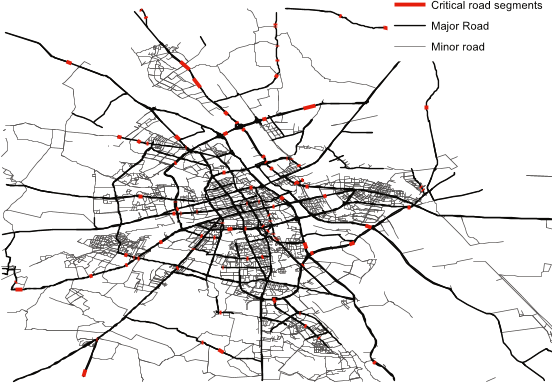 A traffic network in the city of Warsaw, Poland (Source)
A traffic network in the city of Warsaw, Poland (Source)
The food consortium adopts blockchain
Several other food industry players announced the expanded blockchain collaboration with IBM. Aside from Walmart, these include Dole, Unilever, Golden State Foods, Tyson Foods, Kroger, Nestle, McLane Company, and McCormick and Company.
Using IBM’s enterprise-grade blockchain platform, the consortium aims to significantly reduce the time it takes to isolate the source in the event of another food-borne outbreak. “We’re all in the business of trying to improve the quality of life of people that we serve around the world,” added Frank.
IBM’s Brigid McDermott explained that the food blockchain initiative could cut down on the three costs that affect the food supply chain:
- The cost of human health and life
- The cost of recalling tainted food
- The cost of food wasted due to consumer fears
“A blockchain food safety program is tremendously good because it provides transparency into the food system, which means that in the event that there is a problem like a recall, you’re able to quickly, effectively, and surgically deal with that problem.” —Brigid McDermott, IBM
Though this post focuses on food safety in the retail industry, the same points also apply to most if not all businesses in retail. Any industry that relies on a supply chain can be made transparent and more efficient with blockchain.
Improving supply chain with machine learning
Aside from blockchain, Walmart has also invested heavily in IoT, machine learning, and analytics. Up to 240 million customers each week shop at Walmart. Whether they shop on the web, on mobile devices, or in the physical stores, these customers generate copious amounts of data for Walmart.
Data points collected by Walmart allow their developers to create applications such as an in-store mobile navigation systems that enable customers to search for items and see exactly where they are located. There’s also the Walmart mobile app which sees continued development and currently has features including ordering online and picking up orders at a store, refilling pharmacy prescriptions, and finding which stores have a particular item in stock.
Walmart also has an app that generates e-receipts, eliminating the need for paper receipts. These e-receipts makes it easier for customers to return items and also for Walmart to detect item return fraud.
Seasonal sales are major events for Walmart. During the the Black Friday sale of 2016, Walmart served 260 million customers worldwide. The company dealt with terabytes worth of data to ensure a smooth shopping experience for its customers by:
- Predicting consumer purchasing behavior by region by looking at historical data
- Adjusting store inventory based on regional financial strength
- Coordinating with suppliers based on a brand strength
- Stress testing the e-commerce platform ahead of the sale
- Marking down prices bases on consumer behavior
With how much Walmart is investing in digital transformation, we may certainly see a time where the emerging technology of blockchain and IoT for food safety merges with machine learning and analytics. Automated recalls of tainted products perhaps? Only time will tell.
Want details? Watch the videos!
Related reading
- IBM: Blockchain to Transform IoT, Supply Chains, and the World Around Us
- The “Internet of Value”: 8 Top Sectors Being Transformed by Blockchain
- Existing Blockchain Projects Span Financial Services and Supply Chains
About the experts










